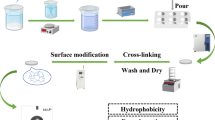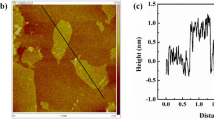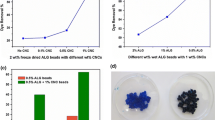Abstract
Since caustic dyes are a major component of wastewater used in printing and dyeing, they represent a significant risk to human health. It’s getting harder to get rid of them efficiently. An appealing solution to this issue is adsorption based on biomass material aerogel. Here, using the sol-gel process and freeze-drying, an inventive three-dimensional porous aerogel (STA) was created using sodium alginate (SA) and TEMPO-oxidized cellulose (TOC) as raw materials, with the dual cross-linking effects of glutaraldehyde (GA) and Ca2+. Various characterization approaches and analytical methods were used to study STA. The results indicated that the addition of TOC resulted in the excellent pore structure, thermal stability, charge characteristic and adsorption capacity of STA. The adsorption capacity of STA was investigated by selecting crystalline violet (CV) as a typical cationic dye. Thereafter, the adsorption capacity was comprehensively analyzed by varying temperature, pH and adsorption time. The adsorption process conformed to the pseudo-second-order kinetic model, and the Langmuir isothermal adsorption model has a better fit, which was a single-molecule layer chemisorption process. The highest adsorption capacity reached 505.9 mg/g. Moreover, STA also possessed outstanding competitive adsorption capacity and cyclic adsorption performance.
Graphical Abstract

Highlights
-
Sodium alginate and TEMPO-oxidized cellulose were combined innovatively, and the application scope of bio-based materials was expanded.
-
A double cross-linking reaction was achieved in the presence of Ca2+ and glutaraldehyde.
-
The largest porosity reached 95.6% as a result of the three-dimensional porous structure.
-
The maximum adsorption capacity for CV reached 505.98 mg/g. Recycling times and competitive adsorption capacity are excellent.
-
The thermal stability was enhanced to some extent due to the addition of TOC.












Similar content being viewed by others
References
Dong T, Tian N, Xu B (2022) Biomass poplar catkin fiber-based superhydrophobic aerogel with tubular-lamellar interweaved neurons-like structure. J Hazard Mater 429. https://doi.org/10.1016/j.jhazmat.2022.128290.
Schroeter B, Yonkova VP, Niemeyer NAM (2021) Cellulose aerogel particles: control of particle and textural properties in jet cutting process Cellulose 28:223–239. https://doi.org/10.1007/s10570-020-03555-2
Sharma PR, Sharma SK, Antoine R (2019) Efficient removal of arsenic using zinc oxide nanocrystal-decorated regenerated microfibrillated cellulose scaffolds. ACS Sustain Chem Eng 7(6):6140–6151. https://doi.org/10.1021/acssuschemeng.8b06356
Park M, Lee DJ, Hyun JH (2015) Nanocellulose-alginate hydrogel for cell encapsulation. Carbohydr Polym 116:223–228. https://doi.org/10.1016/j.carbpol.2014.07.059
Jiang YH, Zhang YQ, Wang ZH (2022) Cotton-derived green sustainable membrane with tailored wettability interface: Synergy of lignin and ethyl cellulose. Ind Crop Prod 183. https://doi.org/10.1016/j.indcrop.2022.114993.
Sharma PR, Chattopadhyay A, Zhan CB (2018) Lead removal from water using carboxycellulose nanofibers prepared by nitro-oxidation method Cellulose 25(3):1961–1973. https://doi.org/10.1007/s10570-018-1659-9
Jiao CL, Li TT, Wang J (2020) Efficient removal of dyes from aqueous solution by a porous sodium alginate/gelatin/graphene oxide triple-network composite aerogel. J Polym Environ 28:1492–1502. https://doi.org/10.1007/s10924-020-01702-1
Deng WF, Tang YJ, Mao JC (2021) Cellulose nanofibril as a crosslinker to reinforce the sodium alginate/chitosan hydrogels. Cellulose 190:890–899. https://doi.org/10.1016/j.ijbiomac.2021.08.172
Guo X, Zhao H, Qiang XH (2023) Facile construction of agar-based fire-resistant aerogels: a synergistic strategy via in situ generations of magnesium hydroxide and cross-linked Ca-alginate. Int J Biol Macromol 227:297–306. https://doi.org/10.1016/j.ijbiomac.2022.12.164
Storer DP, Phelps JL, Wu X (2020) Rice-straw-fiber-based 3d photothermal aerogels for highly efficient solar evaporation. ACS Appl Mater Interfaces 12:15279–15287. https://doi.org/10.1021/acsami.0c01707
Hao X, Yang, SY, Tao E (2022) High efficiency and selective removal of Cu(II) via regulating the pore size of graphene oxide/montmorillonite composite aerogel. J Hazard Mater 424. https://doi.org/10.1016/j.jhazmat.2021.127680.
El-Sayed NS, Kiey SAA, Darwish A (2022) High performance hydrogel electrodes based on sodium alginate-g-poly (AM-c o-ECA-co-AMPS for supercapacitor application. Int J Biol Macromol 218:420–430
Chen H, Sharma PR, Sharma SK (2022) Effective Thallium(I) Removal by Nanocellulose Bioadsorbent Prepared by Nitro-Oxidation of Sorghum Stalks. Nanomaterials. 12 (23). https://doi.org/10.1016/j.carbpol.2020.116348.
Xie Q, Zou YK, Wang YZ (2022) Mechanically robust sodium alginate/cellulose nanofibers/polyethyleneimine composite aerogel for effective removal of hexavalent chromium and anionic dyes. Polym Eng Sci 62:1927–1940. https://doi.org/10.1002/pen.25976
Li WQ, Zhang LP, Hu D (2021) A mesoporous nanocellulose/sodium alginate/carboxymethyl-chitosan gel beads for efficient adsorption of Cu2+ and Pb2+. Int J Biol Macromol 187(2021):922–930. https://doi.org/10.1016/j.ijbiomac.2021.07.181
Zhu G, Isaza LG, Huang B (2022) Multifunctional nanocellulose/carbon nanotube composite aerogels for high-efficiency electromagnetic interference shielding. ACS Sustain Chem Eng 10:2397–2408. https://doi.org/10.1021/acssuschemeng.1c07148
Karimzadeh Z, Namazi H (2022) Nontoxic double-network polymeric hybrid aerogel functionalized with reduced graphene oxide: Preparation, characterization, and evaluation as drug delivery agent. J Polym Res 29. https://doi.org/10.1007/s10965-022-02902-0.
Long LY, Li FF, Weng YX (2019) Effects of sodium montmorillonite on the preparation and properties of cellulose aerogels. Polymers 11. https://doi.org/10.3390/polym11030415.
Sharma PR, Chattopadhyay A, Sharma S (2017) Efficient removal of UO22+ from water using carboxycellulose nanofibers prepared by the nitro-oxidation method. Ind Eng Chem Res 56(46):13885–13893. https://doi.org/10.1021/acs.iecr.7b03659
Das R, Lindström T, Sharma PR (2022) Nanocellulose for sustainable water purification. Chem Rev 122(9):8936–9031. https://doi.org/10.1021/acs.chemrev.1c00683
Liu QY, Liu YQ, Feng Q (2023) Preparation of antifouling and highly hydrophobic cellulose nanofibers/alginate aerogels by bidirectional freeze-drying for water-oil separation in the ocean environment. J Hazard Mater 44. https://doi.org/10.1016/j.jhazmat.2022.129965.
Yang J, Xia YF, Xu P (2018) Super-elastic and highly hydrophobic/superoleophilic sodium alginate/cellulose aerogel for oil/water separation. Cellulose 25:3533–3544. https://doi.org/10.1007/s10570-018-1801-8
Sharma PR, Joshi R, Sharma SK (2017) A simple approach to prepare carboxycellulose nanofibers from untreated biomass. Biomacromolecules 18(8):2333–2342. https://doi.org/10.1021/acs.biomac.7b00544
Liu CY, Liu HY, Xu AR (2017) In situ reduced and assembled three-dimensional graphene aerogel for efficient dye removal. J Alloy Compd 714:522–529. https://doi.org/10.1016/j.jallcom.2017.04.245
Zhang YF, Wu L, Deng HL (2021) Modified graphene oxide composite aerogels for enhanced adsorption behavior to heavy metal ions. J Environ Chem Eng 9. https://doi.org/10.1016/j.jece.2021.106008.
Han XH, Liang JC, Fukuda S (2022) Sodium alginate-silica composite aerogels from rice husk ash for efficient absorption of organic pollutants. Biomass Bioenerg 159. https://doi.org/10.1016/j.biombioe.2022.106424.
Tian YR, Zhang XF, Feng XY (2021) Shapeable and underwater super-elastic cellulose nanofiber/alginate cryogels by freezing-induced oxa-Michael reaction for efficient protein purification. Carbohydr Polym 27. https://doi.org/10.1016/j.carbpol.2021.118498.
Gao C, Wang XL, An QD (2021) Synergistic preparation of modified alginate aerogel with melamine/chitosan for efficiently selective adsorption of lead ions. Carbohydr Polym 25. https://doi.org/10.1016/j.carbpol.2020.117564.
Wang ZQ, Wu SS, Zhang YN (2020) Preparation of modified sodium alginate aerogel and its application in removing lead and cadmium ions in wastewater. Int J Biol Macromol 157:687–694. https://doi.org/10.1016/j.ijbiomac.2019.11.228
Wang SK, Ma XF, Zheng PW (2019) Sulfo-functional 3D porous cellulose/graphene oxide composites for highly efficient removal of methylene blue and tetracycline from water. Int J Biol Macromol 140:119–128. https://doi.org/10.1016/j.ijbiomac.2019.08.111
Feng JZ, Su BL, Xia HS (2021) Printed aerogels: chemistry, processing, and applications. Chem Soc Rev 50:3842–3888. https://doi.org/10.1039/c9cs00757a
Wang FF, Zhang H, Sun YF (2023) Superhydrophilic quaternized calcium alginate based aerogel membrane for oil-water separation and removal of bacteria and dyes. Int J Biol Macromol 227:1141–1150. https://doi.org/10.1016/j.ijbiomac.2022.11.294
Wang M, Yang Q, Zhao XQ (2019) Highly efficient removal of copper ions from water by using a novel alginate-polyethyleneimine hybrid aerogel. Int J Biol Macromol 138:1079–1086. https://doi.org/10.1016/j.ijbiomac.2019.07.160
Feng YL, Wang H, Xu JH (2021) Fabrication of MXene/PEI functionalized sodium alginate aerogel and its excellent adsorption behavior for Cr(VI) and Congo Red from aqueous solution. J Hazard Mater 416. https://doi.org/10.1016/j.jhazmat.2021.125777.
Rong NN, Chen CC, Ouyang KW (2021) Adsorption characteristics of directional cellulose nanofiber/chitosan/ montmorillonite aerogel as adsorbent for wastewater treatment. Sep Purif Technol 274. https://doi.org/10.1016/j.seppur.2021.119120.
Zheng K, Gong WL, Wu MB (2023) Amphoteric cellulose microspheres for the efficient remediation of anionic and cationic dyeing wastewater. Sep Purif Technol 309. https://doi.org/10.1016/j.seppur.2022.123035.
Guo WH, Zhang JB, Yang F (2020) Highly efficient and selective recovery of gallium achieved on an amide-functionalized cellulose. Sep Purif Technol 23. https://doi.org/10.1016/j.seppur.2019.116355.
He XX, Sun CX, Khalesi HD (2022) Comparison of cellulose derivatives for Ca2+ and Zn2+ adsorption: Binding behavior and in vivo bioavailability. Carbohydr Polym 294. https://doi.org/10.1016/j.carbpol.2022.119837.
Wang Y, Li YX, Zhang YP (2021) Nanocellulose aerogel for highly efficient adsorption of uranium (VI) from aqueous solution. Carbohydr Polym 267. https://doi.org/10.1016/j.carbpol.2021.118233.
Zhou SJ, Xia LJ, Fu Z (2021) Purification of dye-contaminated ethanol-water mixture using magnetic cellulose powders derived from agricultural waste biomass. Carbohydr Polym 258. https://doi.org/10.1016/j.carbpol.2021.117690.
Zhang TM, Zhang WW, Xi H (2021) Polydopamine functionalized cellulose-MXene composite aerogel with superior adsorption of methylene blue. Cellulose 28:4281–4293. https://doi.org/10.1007/s10570-021-03737-6
Cheng TJ, Zhang YH, Cui FJ (2022) Preparation of novel ZIF-8 aerogel adsorbent based on cellulose and the application of Cu (II) removal from wastewater. Chem Phys Lett 808. https://doi.org/10.1016/j.cplett.2022.140100.
Dilamian M, Noroozi B (2021) Rice straw agri-waste for water pollutant adsorption: Relevant mesoporous super hydrophobic cellulose aerogel. Carbohydr Polym 251. https://doi.org/10.1016/j.carbpol.2020.117016.
Gao L, Li ZH, Yi WM (2023) Effective Pb2+ adsorption by calcium alginate/modified cotton stalk biochar aerogel spheres: with application in actual wastewater. J Environ Chem Eng 11. https://doi.org/10.1016/j.jece.2022.109074.
Wang XY, Xie PB, He L (2022) Ultralight, mechanically enhanced, and thermally improved graphene-cellulose-polyethyleneimine aerogels for the adsorption of anionic and cationic dyes. Nanomater 12. https://doi.org/10.3390/nano12101727.
He BY, Zhang YY, Li BJ (2021) Preparation and hydrophobic modification of carboxymethyl chitosan aerogels and their application as an oil adsorption material. J Environ Chem Eng 9 https://doi.org/10.1016/j.jece.2021.106333.
Chong KY, Chia CH, Zakaria S (2015) CaCO3-decorated cellulose aerogel for removal of Congo Red from aqueous solution. Cellulose 22(4):2683–2691. https://doi.org/10.1007/s10570-015-0675-2
Cui FJ, Li HD, Chen C (2021) Cattail fibers as source of cellulose to prepare a novel type of composite aerogel adsorbent for the removal of enrofloxacin in wastewate. Int J Biol Macromol 191:171–181. https://doi.org/10.1016/j.ijbiomac.2021.09.022
Dilamian M, Noroozi B (2021) Rice straw agri-waste for water pollutant adsorption: Relevant mesoporous super hydrophobic cellulose aerogel. Carbohydr Polym 25:117016. https://doi.org/10.1016/j.carbpol.2020.117016
Liu K, Chen LH, Huang LL (2018) Adsorption behaviors of acidic and basic dyes by thiourea-modified nanocomposite aerogels based on nanofibrillated cellulose. Bioresources 13(3):5836–5849
Luo MF, Wang M, Pang HP (2021) Super-assembled highly compressible and flexible cellulose aerogels for methylene blue removal from water. Chin Chem Lett 32(6):2091–2096. https://doi.org/10.1016/j.cclet.2021.03.024
Ren LL, Yang ZH, Huang L (2020) Macroscopic poly Schiff base-coated bacteria cellulose with high adsorption performance. Polymers 12(3):714. https://doi.org/10.3390/polym12030714
Wei X, Huang T, Nie J (2018) Bio-inspired functionalization of microcrystalline cellulose aerogel with high adsorption performance toward dyes. Carbohydr Polym 198:546–555. https://doi.org/10.1016/j.carbpol.2018.06.112
Zhang F, Wu WB, Sharma S (2015) Synthesis of cyclodextrin-functionalized cellulose nanofibril aerogel as a highly effective adsorbent for phenol pollutant removal. Bioresources 10(4):7555-7568
Zhang TM, Zhang WW, Xi H (2021) Polydopamine functionalized cellulose-MXene composite aerogel with superior adsorption of methylene blue. Cellulose 28(7):4281–4293. https://doi.org/10.1007/s10570-021-03737-6
Li HM, Huang JY, Shen S (2023) Superhydrophobic sodium alginate/cellulose aerogel for dye adsorption and oil-water separation. Cellulose 30(11):7157–7175. https://doi.org/10.1007/s10570-023-05307-4
Su HZ, Qiu WP, Deng TR (2023) Fabrication of physically multi-crosslinked sodium alginate/carboxylated-chitosan/montmorillonite-base aerogel modified by polyethyleneimine for the efficient adsorption of organic dye and Cu(II) contaminants. Sep Purif Technol 330:125321. https://doi.org/10.1016/j.seppur.2023.125321
Xie Q, Zou YK, Wang YZ (2022) Mechanically robust sodium alginate/cellulose nanofibers/polyethyleneimine composite aerogel for effective removal of hexavalent chromium and anionic dyes. Polym Eng Sci 62(6):1927–1940. https://doi.org/10.1002/pen.25976
Li J, Lei LL, Liu Z (2023) Sodium alginate/polyethyleneimine/polydopamine@cellulose nanofiber composite aerogel as a novel adsorbent for Cr(VI) and dyes removal. Polym Eng Sci 63(10):3492–3506. https://doi.org/10.1002/pen.26462
Jiao CL, Li TT, Wang J (2020) Efficient removal of dyes from aqueous solution by a porous sodium alginate/gelatin/graphene oxide triple-network composite aerogel. J Polym Environ 28(5):1492–1502. https://doi.org/10.1007/s10924-020-01702-1
Vu CL, Chau NDV, Kim HND (2023) Zinc oxide-doped carbon aerogel derived from bagasse cellulose/sodium alginate/zinc nitrate composite for dye adsorption, storage energy and electrochemical sensing. J Chem Technol Biotechnol https://doi.org/10.1002/jctb.7536
Chen ZC, Weng PX, Song YH (2023) Loofah-inspired sodium alginate/carboxymethyl cellulose sodium-based porous frame for all-weather super-viscous crude oil adsorption and wastewater treatment in harsh environment. Carbohydr Polym 323:121450. https://doi.org/10.1016/j.carbpol.2023.121450
Zhuang J, Pan MZ, Zhang YH (2023) Rapid adsorption of directional cellulose nanofibers/3-glycidoxypropyltrimethoxysilane/polyethyleneimine aerogels on microplastics in water. Int J Biol Macromol 235. https://doi.org/10.1016/j.ijbiomac.2023.123884.
Acknowledgements
This research did not obtain any specific grant from funding agencies in the public, commercial, or not-for-profit sectors. This research was grateful for the testing services provided by the Analysis and Testing Center of East China University of Science and Technology, Materials Research Testing Platform of Materials School.
Author information
Authors and Affiliations
Contributions
ZZ: conceptualization, methodology, software, writing review & editing - original draft. JW: communication, supervision, polish, project administration, funding acquisition. KL: validation, investigation. WD: data curation, investigation. XZ: investigation, polish. ZW: supervision.
Corresponding author
Ethics declarations
Conflict of interest
The authors declare no competing interests.
Additional information
Publisher’s note Springer Nature remains neutral with regard to jurisdictional claims in published maps and institutional affiliations.
Rights and permissions
Springer Nature or its licensor (e.g. a society or other partner) holds exclusive rights to this article under a publishing agreement with the author(s) or other rightsholder(s); author self-archiving of the accepted manuscript version of this article is solely governed by the terms of such publishing agreement and applicable law.
About this article
Cite this article
Zhang, Z., Li, K., Dong, W. et al. An ingenious construction of porous sodium alginate/TEMPO-oxidized cellulose composite aerogels for efficient adsorption of crystal violet dyes in wastewater. J Sol-Gel Sci Technol (2024). https://doi.org/10.1007/s10971-023-06299-0
Received:
Accepted:
Published:
DOI: https://doi.org/10.1007/s10971-023-06299-0




